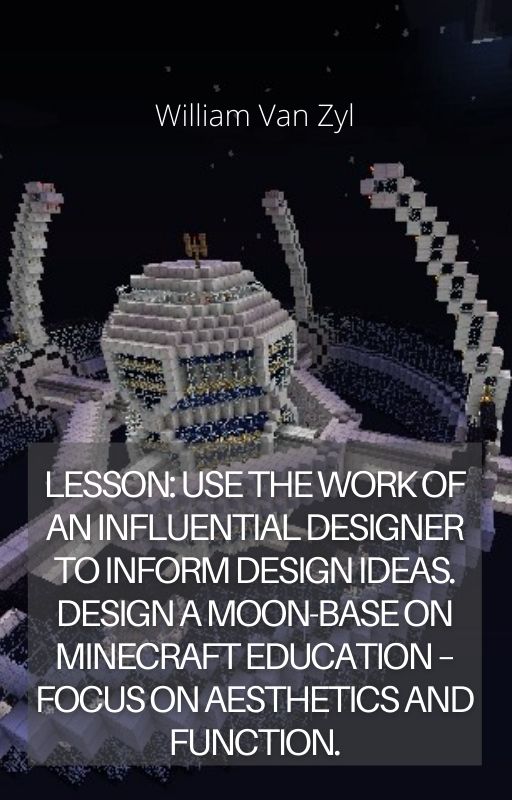$0.00
Read the full Lesson as a blogpost:
https://fivehousepublishing.com/2022/04/02/lesson-use-the-work-of-an-influential-designer-to-inform-design-ideas-design-a-moon-base-on-minecraft-education-focus-on-aesthetics-and-function/
Design Brief:
Design a Moon-dwelling or a Moon-base (in your groups or individually) on Minecraft Education. Use the work of an architect considering aesthetics (beauty). But, more importantly, functionality. Choose an Architectural Design Era or Style (for example, Modernism, Minimalism, Hi-Tech. and more). Also, embed sustainability and scientific features and functions into the design.
Situation:
You have been asked to successfully investigate the essential aspects of living on the Moon. Bjarke Ingels – a well-known architect – is an example of an architect who has explored buildings suitable for living on the Moon. Design eras to consider are Modernism, Minimalism, and Hi-Tech. You have to use Bjarke’s ideas – or the concepts of other designers and architects – to inform your ideas and concepts. With this new knowledge, create a beautiful and practical Moon-dwelling or Moon-base in Minecraft.
Learning Intentions:
- Learn about architectural design eras and styles (Modernism, Minimalism, Hi-Tech, and more).
- Learn how Bjarke uses his architectural genius to design unique and practical buildings – or another architect’s design ideas (your choice). Implement their design ideas combined with your own architectural design ideas in the Moonbase or Moonhouse.
- Learn about, and explore scientific and technological possibilities, when planning and designing a building on another planet, like the Moon.
- Consider how Redstone works for ‘electrical and mechanical’ circuits in Minecraft. Learn how to use it in your design as a tool to make your building more efficient and sustainable.
- Learn about applying aesthetics (beauty) and function when designing the Moon building or base.
- Learn how to embed sustainability into the building. Considering aspects like recycling of building materials, harvesting energy from the Sun, mining minerals for building materials on the Moon for construction purposes, and more.
- Learn how to use existing and new Minecraft knowledge, tools, and applications to design an efficient building or base on the Moon. For example, implementing Minecraft Code.
- Learn how to develop systems – like oxygen systems – for your Moon habitat.
- ADDITIONAL: Learn how to model the Lunar base on TinkerCad. Learn how to make a 3D print on a 3D printer.
Important to consider and include in your design and presentation:
- You have to find an influential architect and design a Moon Building like Bjarke Ingels. There are more designers and architects available. Find an architect whose designs you like. Your choice of an architect. Search ‘Moon architects ‘ or Lunar architects.’
- Paste Bjarke’s (or another ‘Moon-architect’s’ – your choice) biography and some of their designs in a Google Doc (as always, share with the teacher). Comment on the design era or style. Create a table as shown in this unit of work, and compare your work with the work of your chosen architect.
- After scrutinising these ideas, show resemblances of their design work in yours – if any. In other words, there must be some ideas and concepts in your Minecraft design that sort of match his ideas or has inspired you. Point it out. You are going to use his ideas to inform your ideas (inspire your designs on the moon using Minecraft).
Description
More on Project Olympus by Ingels.
Annotation below the image (screenshot). See the above image (YouTube Screenshot): This is a square 3D-printed building for the Moon. Most space buildings are round because the 3D printers are in the centre of the building. It uses the dust of the planet and trunks around and around 3D printing the building. Round buildings are restricted, in my opinion. Bjarke Ingels has shown how square-shaped structures could be printed. I will be using Minecraft Education to construct our buildings.
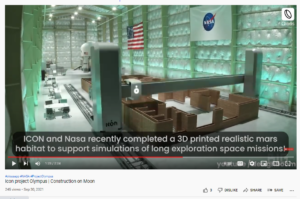
.Video link: https://youtu.be/1mCsqYbQthU
- Your design ideas should show some resemblances to your design work on the Moon. In other words, there must be some ideas and concepts in your Minecraft design that sort of match his ideas. You will use their ideas to inform your ideas (inspire your designs on the Moon using Minecraft).
- You will get points if you have a biography and several images of a chosen ‘Moon Architect’ in your Google Doc. Must include comments below the images referring to the architectural style, materials, practicality, science inspiration, etc. Then screenshots of your Moon Building have to be pasted (screenshots) into the Doc.
- Lastly, you will compare (write up text) to show how these designs have inspired you.
Here are some exemplar ideas for the structure of the assessment. Yours have to look like this. However, the content will be different – it will be moon architecture.
Here is a product design inspired by an architect’s work:
NORMAN FOSTER: CHAIR DESIGN
Norman Foster’s work is often sleek, modern and high-tech, creating cinematic backdrops to everyday life. High-Tech architecture incorporating Sustainable Design.
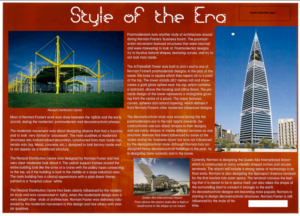
Examples of Norman Foster’s architecture: STYLE: Modern, Minimal, Hi-tech, and Sustainable.
Building designs by Norman Foster: Modern, Hi-tech and Sustainable.
Typical Norman Foster Chair. Citic Bank in China by Norman Foster
Typical Norman Foster Chair (left) and a modern building design (right) by his architectural firm. Sir Norman Foster’s work is often sleek, modern and high-tech, creating cinematic backdrops to everyday life. His firm, Foster + Partners, has projects worldwide, and they continue to develop progressive works of High-Tech architecture incorporating Sustainable Design.
Exploring design ideas: Chair designs based on the Modern, Minimalist, and High-tec style of Norman Foster.
Exemplar NZQA (New Zealand). Student work (16-year old): https://
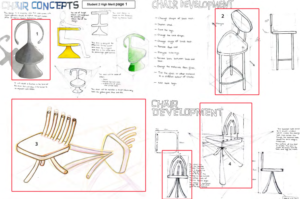
www.nzqa.govt.nz/assets/qualifications-and-standards/qualifications/ncea/NCEA-subject-resources/DVC/91067/91067-EXP.pdf
*The template starts here (make a copy and start making changes).
Modernist Architecture: Pioneering design by Le Corbusier (designed in 1929).
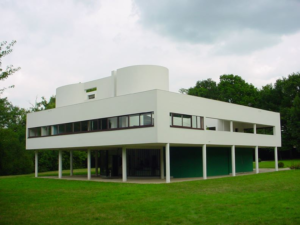
Example: Villa Savoye – by Le Corbusier (Modernism & Minimalism, Hi-Tech). Credit: https://en.wikipedia.org/wiki/Villa_Savoye
